Leather is probably one of the oldest and mostly widely utilized materials for making clothing, shoes, purses and scores of other everyday items. In 2012 this durable and flexible media is continuing to make inroads in the digital printing market. Recent developments in digital printing technology are providing print shops with new options to produce a vibrant array of one-of-a-kind custom products. Today, digital printing graphics onto leather provides a variety of applications for a diverse cross section of niche markets, from high-end fashion wear and accessories to specialty items to automotive and home interiors.
Room for Growth
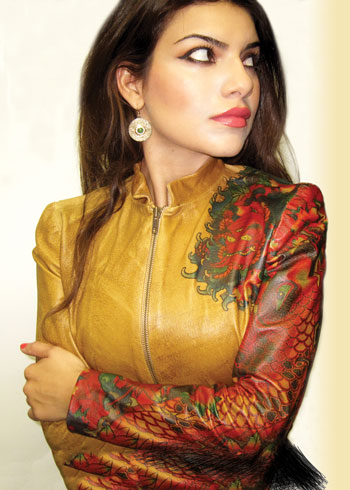 |
Leather FX offers a process called “digital image transfer” for imaging onto leather products such as this leather fashion jacket. The process can even be used to image onto snakeskin. (Images courtesy of Leather FX) |
In the United States, the market demand for “digital leather” is still in its infancy but there is plenty of room for growth.
“Right now European countries such as Italy seem to be the hot spots for digital printing onto leather. The fashion designers in Europe have fully embraced the digital leather concept. That’s a major reason for its success overseas,” says Paul McGovern, national sales manager IP/TA, Mimaki USA, Suwanee, Ga. “Right now the U.S. is still a fairly untapped market and one we intend to heavily target going forward,” he adds.
“The capability to output onto leather gives print businesses an entry into a number of new markets, most notably the specialty advertising market. Right now, we are seeing the majority of printing that is being done on leather for customization of promotional items such as leather bracelets, key chains, covers for laptops, iPods and iPads as well as other accessories,” adds Hiroshi Ono, group product manager, Roland DGA Corp., Irvine, Calif. “Within the specialty advertising industry, there is a demand for customized products across many applications and substrates, including leather. Digital printing is a very efficient solution for this type of product decoration, and businesses that have the right digital printer can profit from offering custom-printed leather goods.”
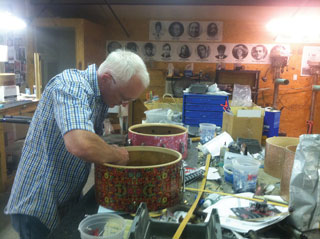 |
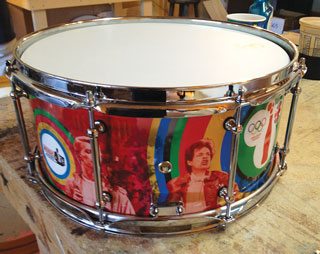 |
Bill Cardwell of C&C Custom Drums utilized Infinium to decorate custom drums for the closing ceremonies of this summer’s Olympic Games. (Images courtesy of LexJet.) |
New Technologies
In the past, output providers had been using screen printing and dye-sublimation inkjet printing onto leather, but now more economical technologies are helping change the playing field.
Last year, LexJet rolled out a product called Infinium which it describes as a “fully transportable” graphic print medium with laminate and adhesive built into one conformable material. Developed by Sarasota, Fla.-based Avatrex, Infinium is compatible with low-solvent, solvent, and latex ink systems; and can be applied to virtually any surface, including irregular surfaces and curves, using heat, water or a primer. However, “The killer application for this product is leather,” says Jeff Leto, product manager at LexJet. “By printing to leather, output providers can charge a premium price for these services.”
According to Leto, this technology enables on-demand mass customization of leather products by providing a photographic image quality, no change to the feel of the material, and improved durability compared to sublimation-printed leather.
“Fully transportable means that, with Infinium, you can print the same material with the same image on the same printer for use in multiple applications,” Leto says. “This conformable material gives you the ability to take the graphic anywhere you want onto virtually any substrate and image it.”
He explains that Infinium is printed in reverse and applied to the substrate.
“It’s a clear material,” Leto says. “You reverse print onto it and apply it face-down on the substrate. And, depending on whether the graphic is temporary or permanent, you apply it using either water, heat or a primer. This process is a new way of thinking. You can print on the transportable coating so you are not married to a particular substrate anymore. It’s a big departure. Now you don’t have to worry about what substrate you print on.”
Leto also reports that a number of businesses out there that are using this process for some interesting applications. He says that one consumer company, Shoe Attitude, allows consumers to decorate their sneakers with graphic designs at home.
“Infinium is the eco-solvent and solvent version and LexJet has the exclusivity. Shoe Attitude uses the aqueous product and they have the exclusivity for that application,” he adds.
Marching to a Different Beat
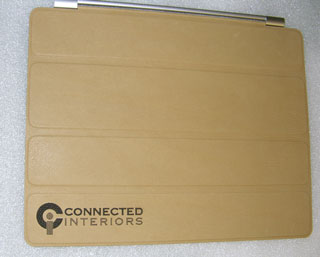 |
Wausau Awards & Engraving uses its laser engraver to image onto leather. The two-tone of the logo on this iPad cover was achieved by setting part of the logo at black and part at 60% grayscale. (Image courtesy of Wausau Awards & Engraving.) |
“In addition to leather, Infinium works a number of other substrates including wood. For example, when custom drum maker, Bill Cardwell of C&C Custom Drums in Gladstone, Mo., was working on a major project of decorating custom drums for the closing ceremonies of this summer’s Olympic Games he found out about our product,” says Leto Cardwell was introduced to the material that would make this particular project work by Mike Bertram, a doctor with a drumming habit who’s been working on a simple and efficient way to produce custom drum graphics. Cardwell got the images from Coca-Cola, one of the sponsors of the closing ceremonies, and Bertram had the images printed in reverse on LexJet Infinium and sent to Cardwell to apply to the drums. Cardwell says he applied the graphics with a drop of dishwashing liquid and water and it went on smoothly and easily.
“Infinium is typically applied with heat and pressure for more permanent applications, conforming to the material to which it’s applied and essentially becoming part of that material. However, since this was a temporary application and time was of the essence, a ‘cold’ application worked just fine,” he says.
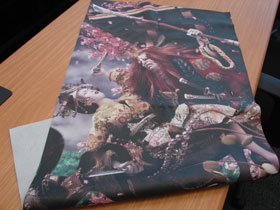 |
Mimaki has been using its JFX line of flatbed printers with Mimaki’s LF-140 flexible UV-curable inks to image onto leather. The successful results is drawing interest from many of the heavy hitters in fashion industry such as Coach and Ralph Lauren. (image courtesy of Mimaki USA) |
Mimaki Looking at Flatbed Route
Mimaki has long been a leader in the textile printing market with their line of textile printers, but now they are also creating a buzz in the leather market by employing their JFX line of LED-based UV-curing flatbed printers.
“We have discovered that our JFX line of flatbeds used with Mimaki LF-140 inks work very well for printing onto leather,” McGovern explains. “These very flexible UV inks offer a rich gradation in six-color printing reducing granular appearance. The leather holds the ink’s colors very well. In addition, the LED UV cure-lamps on the flatbed unit are very gentle on the leather material. We have had great success printing onto lighter Pearl leather. This type of material makes the colors really pop.”
He points out that Mimaki’s leather printing process is drawing an interest from some heavy hitters in the fashion industry including Coach, Christian Dior and Ralph Lauren, as well some sports footwear companies.
Print Solutions from Roland
Roland offers a number of print solutions for this market, says Ono.
“For our wide-format VersaUV printers, the LEC series and the LEJ-640, the process is similar to that of any roll media,” he says. “You simply load your roll of leather media onto the printer and you are ready for production. The LEC series, offered in 30" and 54" models, prints and cuts your graphics into virtually any shape. The 64-inch LEJ-640 accepts flat substrates as well, up to a half inch thick.”
He adds that by using their compact VersaUV LEF-12 flatbed printer, users can print directly onto leather objects up to 11 inches by 12 inches and 3.94 inches thick, including wallets, smart phone covers and key chains. “What makes these print devices so unique is their versatility. All VersaUV printers come with CMYK, white and clear UV inks, which produce bright saturated colors. VersaUV’s white ink images well onto leather media. Clear inks can be used to add textures and high gloss spot varnishing effects on leather items for added visual impact. With each of these devices, you can print directly onto leather substrates with no retreatment.”
Ono adds that sign shops should really look at this market. “Printing on leather can bring additional revenue to a sign business. Leather is appreciated as a high-end material and commands a high price tag. The ability to customize leather products with printed graphics and text increases their value perception to the customer and is a great way to diversify your business,” he concludes.
Leather FX Fashion Statement
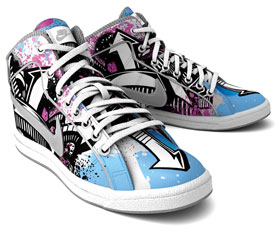 |
Breakthroughs in printing technology have added leather to the many substrates available to sign shops. |
Glendale, Calif.-based Leather FX offers a process of leather decoration called digital image transfer on leather. “We started out in the fashion industry and have since moved into other markets. Basically, we can print anything directly onto leather,” reports company president, Ruben Gevorkian.
“We do all the digital printing at our location,” Gevorkian says. “A few years ago we converted our Mutoh roll-to-roll printer into a flatbed machine. The ability to apply graphics to leather gives designers unlimited opportunities to create their leather pieces with color images. No more painstakingly slow and expensive hand painting or even more expensive screen printing. With our process it is possible to create truly unique custom leather pieces—one piece at a time—or do large production runs—whether it be footwear, furniture, book covers, car seat covers, clothing or accessories.”
Gevorkian points out that their proprietary process allows them to create leather goods with consistent, durable graphics on leather—any leather, be that crust, coated, dyed and everything in between.
“Handbags, boots, shoes or jackets...everything we produce is custom made,” Gevorkian says. “We can even put images on exotic skins such as python, alligator, snake and ostrich. Our process is direct onto leather so we don’t have to use a laminator. Once applied, the image bonds permanently to the leather, becoming part of it. It will retain the natural beauty and the feel of leather with added benefit of full color image on top of it.
“This process allows for both short custom runs as well as long production runs. And it’s eco-friendly—there are no solvent inks or laminating films applied to leather. There are no size limitations—except the size of the skin. We can put images on leather panels as well as pre-cut patterned pieces,” he concludes.
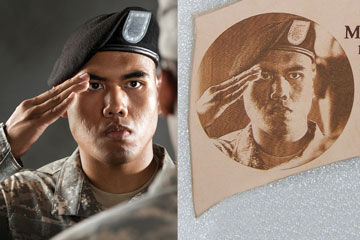 |
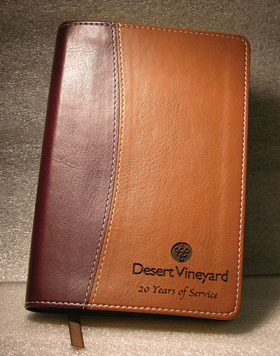 |
Engraving Leather by Laser
In addition to digital printing, laser engraving is another way to apply graphics to leather.
“Laser engraving on leather products has been a growing market for us,” says Michael Erwin, vice president at Wausau Awards & Engraving, Wausau, Wis. “We laser engrave light colored leather including wallets, portfolios, journal covers, and more.” The shop does their engraving on a 40 and a 60 watt machine from Universal Lasers Systems.
Erwin explains that the process of laser engraving is where a laser burns text, logo or design into the leather.
“In the laser engraving process on leather, we can burn any text, logo, or design that we can setup on the computer,” he says. “The quality of the final imprint depends on the original artwork. If you have a vector format file of a logo, that quality will be very good. High quality JPG files work as well.”
He says that laser engraving on leather works best on light or brown
colored leathers. For visibility from a distance, light colored (tan,
white, light brown, medium brown) seem to work best. For reproducing
photos or detailed artwork (reproduced as a half-tone print like
newspaper images) you almost invariably need a hard-surfaced
high-quality leather that is light in color,” he says
He points out that they have found that dark colored leathers (black and deep brown) don’t provide much contrast.
“For black leather, we usually recommend engraved metal plates affixed to the surface which can hold either text or logos,” Erwin says. “The specific nature of your leather item determines the manner of engraving, embossing, or debossing we will be able to perform on the item.”
Primarily we use leather products provided by the customer. Laser Bits (www.laserbits.com)
sells a variety of real leather products that work well for laser
engraving; we use some of their plaque plates and tags from time to
time. Laser Bits also sells Fiebing’s Leather Sheen, which we use in
some cases to seal or finish off the engraving. The necessity of that
really depends on the leather itself,” he concludes.



